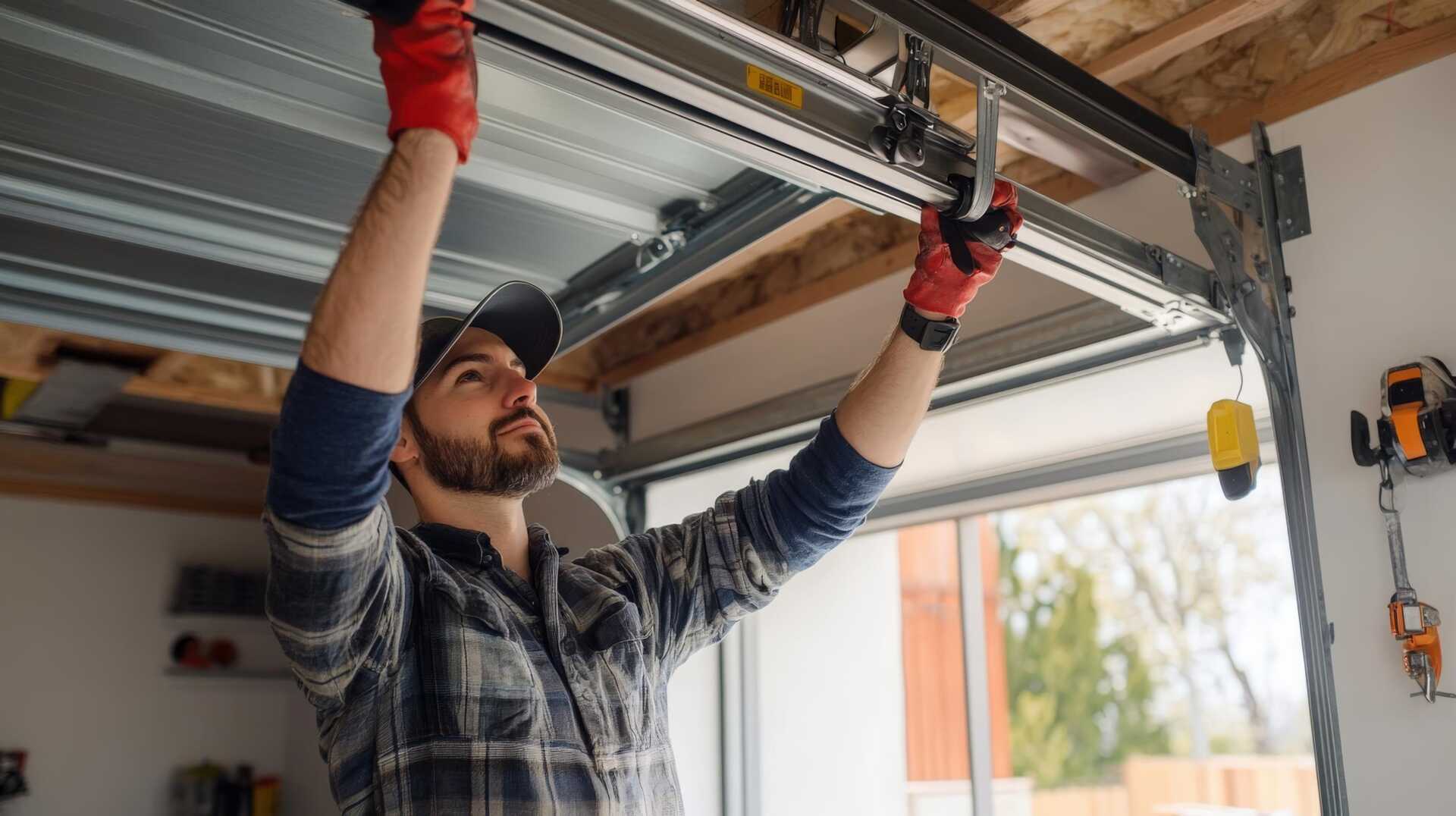
Contents
Many believe that overhead garage door installation is straightforward, but the reality is often quite different. Numerous errors can arise during the process, from incorrect measurements to improper track alignment. These mistakes can lead to serious operational and safety issues. It’s essential to understand which pitfalls to avoid to ensure a functional and secure garage door system. What are the specific errors that can compromise your installation efforts?
Key Takeaways
- Failing to take accurate measurements can lead to improper fit and functionality issues with the overhead garage door.
- Skipping proper alignment and leveling of tracks can cause uneven door movement and increased wear on hardware.
- Neglecting safety features, such as sensor placement and testing, can pose risks to people and property.
- Choosing the wrong door type or material impacts functionality and security and may affect resale value.
- Improper tightening of hardware and managing spring tension can lead to malfunctions and safety hazards.
Incorrect Measurements and Sizing
When you tackle overhead garage door installation, one of the most critical aspects is ensuring accurate measurements and sizing. Using reliable measurement tools is essential for achieving the perfect fit.
Start by measuring the width and height of your opening, as well as the depth of the header space. Follow established sizing guidelines to account for any variations in your garage structure.
Don’t forget to measure the distance from the floor to the top of the opening, as this can affect the door’s operation. Double-check your measurements before purchasing your door to avoid costly mistakes.
If you’re unsure, consult a professional or refer to manufacturer specifications for assistance. Accurate measurements ensure a smooth installation, and the door functions correctly, enhancing your garage’s security and efficiency.
Taking the time to measure correctly will save you frustration in the long run.
Neglecting Safety Features
When installing an overhead garage door, it’s vital to prioritize safety features like sensors and proper wiring techniques.
Neglecting these elements can lead to malfunctions and safety hazards.
Regular maintenance checks are also important to ensure everything operates smoothly and safely.
Importance of Safety Sensors
Safety sensors are a critical component in modern garage door systems, ensuring protection for both people and property. Neglecting these sensors can lead to serious accidents.
Proper sensor placement is essential; they must be installed at the appropriate height and aligned correctly to detect any obstacles in the door’s path. Adhering to safety regulations safeguards your family and prevents potential damage to your vehicle and garage.
If you’re installing an overhead garage door, don’t overlook the importance of these safety features. They’re designed to provide peace of mind, making your garage a safer space for everyone.
Proper Wiring Techniques
Proper wiring techniques are essential for ensuring your overhead garage door operates smoothly and safely.
When installing your garage door opener, pay close attention to wire gauge selection. Using the correct gauge ensures that the electrical current flows efficiently, preventing overheating and potential failures. A wire that’s too thin can cause resistance, leading to performance issues.
Additionally, ensure that you install a properly rated circuit breaker to protect your system from overloads. This safety feature is critical; it cuts off power during faults, safeguarding your garage door opener and preventing fire hazards.
Regular Maintenance Checks
Regular maintenance checks are essential for ensuring your overhead garage door operates reliably and safely. Neglecting safety features during these inspections can lead to serious accidents.
You should perform regular inspections of the door’s balance, sensors, and emergency release mechanisms to identify potential issues before they escalate. Scheduled upkeep is key; it helps maintain the integrity of safety features designed to protect you and your family.
Don’t overlook components like springs and cables, as wear and tear can compromise functionality. By prioritizing these checks, you extend the life of your door and foster a secure home environment.
Improper Track Alignment
When installing an overhead garage door, confirming the tracks are aligned correctly is essential, as misalignment can lead to operational issues and potential damage. You need to prioritize track stability throughout the installation process.
Start by using alignment tools, such as a level and measuring tape, to check that both tracks are parallel and at the same height. If the tracks aren’t aligned, the door may bind, leading to wear and tear on the components.
Also, keep an eye on the vertical and horizontal sections of the tracks; slight deviations can cause significant problems. Adjust the brackets as necessary to achieve the perfect alignment.
After making adjustments, double-check everything to confirm it’s secure and stable. By taking the time to align the tracks properly, you’ll enhance the door’s functionality and extend its lifespan, confirming a smooth operation for years to come.
Failing to Secure Hardware
After confirming the tracks are aligned, the next critical step is securing all hardware components properly. Failing to do so can lead to significant issues down the line.
You’ll need to work with various hardware types, including brackets, hinges, and rollers, all of which must be tightened to the manufacturer’s specifications. Make sure you’ve got the right installation tools on hand, like a socket set and a torque wrench, to verify everything is secured correctly.
Double-check each connection and fastener, as loose hardware can cause misalignment and premature wear.
Remember, even small mistakes in this stage can lead to larger problems, such as the door malfunctioning or becoming unsafe. By prioritizing proper hardware security, you’re not just following best practices; you’re ensuring safety and longevity for your overhead garage door system.
Take the time to do it right, and you’ll feel confident in your installation.
Ignoring Spring Tension
One of the most vital aspects of overhead garage door installation is managing spring tension, as improper adjustments can lead to serious safety hazards.
When you ignore spring tension, it can cause the overhead garage door to malfunction or even collapse, posing risks to you and your property.
It’s important to ensure that the springs are correctly calibrated to support the weight of the door. If you’re unsure, consult the manufacturer’s specifications or seek professional help.
The right tension is vital for the smooth operation and longevity of your overhead garage door system.
Never attempt to adjust spring tension without the proper tools and knowledge, as this can result in injury.
Always prioritize safety by wearing protective gear and following best practices during installation.
Overlooking Weather Sealing
While it might be tempting to focus solely on the mechanics of your overhead garage door, overlooking weather sealing can lead to significant energy loss and increased maintenance costs.
Proper weather strip installation is essential in preventing drafts and moisture damage, which can affect both your garage and your home.
Seals around the door frame ensure that outside elements don’t infiltrate your space, maintaining a stable temperature and reducing energy bills.
If you skip this step, you might find yourself dealing with rust, mold, or structural damage over time.
Make certain to regularly inspect and replace worn or damaged weather strips to keep your garage in top shape.
Investing in quality weather sealing isn’t just about aesthetics; it’s a practical measure that enhances your home’s energy efficiency and longevity.
Inadequate Opener Installation
Inadequate opener installation can lead to significant operational issues.
If the opener isn’t mounted in the correct position, it can create strain on the door mechanism.
Additionally, improper wiring connections can result in malfunctioning controls, posing safety risks and reducing efficiency.
Incorrect Mounting Position
When the garage door opener isn’t mounted correctly, it can lead to significant operational issues and safety risks.
To verify proper installation, keep these key factors in mind:
Mounting Height: Install the opener at the recommended height to avoid strain on the door mechanism.
Vertical Alignment: Confirm the opener is vertically aligned; misalignment can cause uneven door movement.
Horizontal Leveling: Check that the opener is horizontally level to prevent binding during operation.
Secure Fastening: Use appropriate fasteners to ensure that the opener remains securely in place.
Neglecting these aspects can create alignment issues, resulting in malfunction or premature wear.
Investing time in correct mounting will enhance your overhead garage door’s functionality and safety.
Improper Wiring Connections
Mistakes in the mounting position can lead to another critical issue: improper wiring connections. When you overlook wiring diagrams or fail to follow them closely, you risk compromising electrical safety. This can result in short circuits, malfunctioning openers, or worse—fire hazards.
| Error Type | Consequence | Prevention |
|---|---|---|
| Incorrect Connections | Malfunctioning Opener | Follow Wiring Diagrams |
| Loose Wires | Electrical Shorts | Secure Connections |
| Exposed Wires | Safety Hazards | Use Proper Insulation |
| Wrong Voltage | Opener Damage | Verify Before Wiring |
| Neglected Safety | Personal Injury | Always Adhere to Codes |
Skipping Leveling Procedures
Although it might seem like a minor detail, skipping leveling procedures during garage door installation can lead to significant long-term issues.
Proper leveling techniques are essential for ensuring that your garage door operates smoothly and efficiently. When you neglect this step, you risk encountering various alignment issues, which can escalate repair costs and frustration.
Consider these potential problems:
- Uneven door movement, causing wear on the hardware.
- Increased energy consumption due to improper sealing.
- Difficulty in opening or closing the door, leading to safety hazards.
- The shortened lifespan of the door and its components.
Wrong Door Type Selection
Choosing the wrong type of garage door can lead to a cascade of issues that compromise functionality and security. When selecting your door, it’s essential to understand the various door material options available, such as steel, wood, and fiberglass.
Each material offers distinct advantages and disadvantages, impacting durability, insulation, and maintenance requirements.
Additionally, you need to take into account door style compatibility with your home’s architecture. Whether you prefer traditional raised panels or modern minimalist designs, the right style enhances your home’s aesthetic and can even affect resale value.
Before making a decision, evaluate how each option aligns with your specific needs and preferences.
Insufficient Maintenance Preparation
Proper selection of a garage door is only the first step; neglecting maintenance preparation can lead to significant issues down the line.
To ensure your garage door operates smoothly and lasts longer, follow this maintenance checklist:
Inspect the door regularly for wear and tear; check for frayed cables and rust.
Lubricate moving parts like rollers, hinges, and tracks to prevent squeaks and ensure smooth operation.
Test the auto-reverse feature to ensure safety, preventing accidents or injuries.
Clean the tracks and sensors to remove debris that can hinder functionality.
Incorporating these preventive measures will enhance performance and save you from costly repairs.
Recap
To avoid costly complications, careful consideration is essential. By prioritizing precise measurements, proper placement, and safety features, you can prevent pitfalls in your overhead garage door installation. Don’t dismiss important details like spring tension or hardware security; these factors are critical for a seamless system. Remember, the right door type and regular maintenance lead to lasting longevity. Stay vigilant and thorough to ensure your garage door operates safely and efficiently for years.
Recent Posts
Top 5 DIY Garage Door Maintenance Tips
Your garage door is like the gatekeeper to your home, and keeping it in top
Reliable Signs Your Overhead Door Requires Attention
Many homeowners overlook the subtle signs that indicate their overhead door needs attention. Unusual noises
3 Key Tips for Garage Door Care
Picture your garage door gliding smoothly, a seamless entry into your home. To achieve this,

